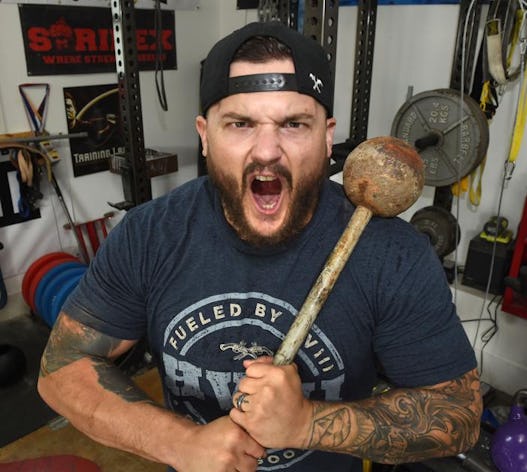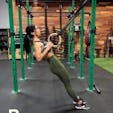“Traveling,” to many people, means “vacation.” Whether you’re on the road for business or pleasure, there’s a tendency to leave the healthy habits you normally keep at home, skip workouts, and eat like the calories don’t matter. But Matt Vincent isn’t “many people.”
He’s a two-time Highland Games champion who’s gone on to found an apparel company—HVIII Brand Goods (pronounced “hate”)—that makes fitness wear for people who don’t want to advertise their fitness, and a podcast (UMSO) about¦ pretty much whatever the hell he feels like at the moment. While he travels the world for work and for fun, he maintains a strict training regimen and disciplined eating, continually posting tips for both on his Instagram. When he stopped in Austin, TX, this summer, he shared some with Onnit, along with his philosophies on strength training, competition, and the chainsaw-wielding Leatherface.
Onnit: You made your name competing in various strength competitions—Highland Games, strongman. Can you tell us about the differences between them?
Vincent: Highland Games is based on Scottish heavy athletics. The history behind that is that when the English took over Scotland and took away their weapons and didn’t let them train for battle, the Scottish clans started having competitions as a way to train for war that didn’t seem like training for war. Throwing rocks¦ manhood test kind of stuff. So we do stone throwing in the competitions. You’ll have a 56-pound weight and a 28-pound weight and you throw them for distance. The stones were used on farm scales as a counterbalance for when they weighed grain. You have two hammers that you throw that were used to hammer stakes into the ground. It’s just a ball on the end of a stick. You’ve got the caber throw. There are rumors as to what the caber represented, but essentially you’re taking a telephone pole, picking it up, and running with it, and trying to flip it end over end.
While World’s Strongest Man and Highland Games are both strength tests, with World’s Strongest Man, the weights keep increasing. Whereas with the Scottish Highland Games, the weights are set, so the implements are the same; you’ve got to throw them further. Max strength isn’t the only answer. You’ve got to be quick and athletic, and technique is a bigger part of it than in strongman where more raw power is going to be necessary.
It seems like Highland Games is more a test of brute strength—short events. Whereas World’s Strongest man has more events for distance and endurance-focused stuff.
Yeah, everything we throw happens in about half a second. It is brute strength, but you also have to be really fast and explosive. The heaviest thing we throw is 56 pounds. So if I’ve got a 400-pound clean, I need to figure out how to translate 400 pounds of clean force into a 56-pound item. You can’t do it slowly. You’ve got to be able to hit the accelerator and push force into the implement to get it out.
What were the events that you excelled at?
I was really good in stones. I tied a world record, 63 feet, with a 16-pound stone. I threw the weights well, 94 feet with the light weight. I broke the American record at the time. I was really good in those four events of the nine. The other ones I was pretty solid.
What were some of your best lifts in general—be it powerlifting, in the gym, Highland Games, or anything else you’ve done?
I’ve snatched 335 pounds, clean and jerked over 400. I’ve push pressed 200 kilos [440 pounds]; bench press was 440 pounds. I deadlifted 700 pounds and squatted 685.
You wrote about your training in the book Training Lab. You’re a big advocate of submaximal training. Can you describe how that goes?
A big part of that, going back to the Highland Games, is using lighter weights and moving them quickly. I need horsepower. I need explosive power. If I can have max strength, like a 700-pound squat, but it takes me three seconds to complete that lift, that’s not really beneficial for me to accelerate a submaximal weight. I like submaximal training because I don’t believe those really heavy singles are going to improve your strength. At the end of the day, what’s making you stronger is the accumulation of work done over a long time. Being able to squat 600 for 3 yields more total poundage than, say, 700 for 1.
What do the sets and reps look like with that kind of training?
I broke it down into three blocks. I had a high volume block that I started my off-season with. It was 10 weeks of 10×10. I’d stay around 50–60% [of my maxes]. This was a time for me to rebuild and fix a lot of stuff that throughout the season gets busted, and the body needs some time to heal up. I fix the imbalances that happen from being a one-sided athlete and throwing. So 10 weeks of that is just me setting a foundation. At the end of that I would always test and see what a max 10 looks like. I’ve squatted 515 for 10.
Then I’d go into a speed block, which is like 12 sets of 3, and nothing got over 75%. What I cared about was how fast I was moving the barbell. I trained with a Tendo unit, or some kind of velocity tracker. So it was, “What’s the heaviest set of 3 today where I can still move the barbell at a meter a second?” That translates more into what my sport was than just max output. Then I got into strength work that was 5 sets of 5, 5 sets of 3, 5 sets of 1, but nothing over 90%. I felt the reward ratio of going over 90% got outweighed by the risk. The more work I could do without getting hurt, the better I’d perform when I compete. It didn’t make any sense for me to be the strongest in the gym and then do really bad in a competition setting.
That’s interesting, because a lot of athletes, especially powerlifters, really like the max-effort method, going over 90%. And the criticism against that is the injury potential. Have you been able to avoid injuries with this kind of training?
[Laughs] I haven’t been able to avoid injuries but I don’t think the training was a cause of it. I think it was overuse and bad luck and whatever comes with it. I think risk of injury comes with doing any athletic thing. Any type of training can be healthy and beneficial long-term. But if you have decided to be the absolute strongest you can be, or be the best in the world at a thing, we’ve waved bye-bye to health. We are solely chasing performance. And at some time, Father Time wins. Injuries are going to rack up as you get older.Let’s talk about what happened to your knee.
I had nine knee surgeries that wrapped up the end of my career, and finished in 2016. It’s not like I had a moment where the knee busted. Nothing exploded. I had torn a meniscus training, and at the end of that season I got it fixed, took a month off, and got back to competing. The plan was to repair an ACL that I had gone 10 years without. I wore out that knee with all the spinning and turning on grass. So when the meniscus gave I tried to fix the ACL¦ apparently my body doesn’t care for cadaver tissue very much. It rejected four ACLs. And you don’t figure out that it’s rejected until you’ve done three months of rehab and realize it’s not there. And then you just start over again.
So you’ve had a total knee replacement now?
Yeah. I’ve got full robot parts in there, and it seems to be better.
What’s the rehab been with that?
You’ve got to be smart with it. What are the big goals? They’re to get out of pain, add range of motion, and reduce inflammation. After we cross that threshold, we can start working on strength again. Because strength is what’s going to stabilize the joint. Now, I don’t ever need to pursue max strength again, but there’s still some level of strength I care to have, and I’ll always push strength, but I can do it through repetition and more hypertrophy work.
How long ago did you have the knee replaced?
Eleven weeks. Right now I’ve just gotten back into my second week of following the strength work in Strength Lab and Training Lab, the books I’ve written. Strength Lab is like Training Lab, but not throwing-based. I started doing volume again—so it’s 10 sets of 10 on the main lifts, not going over 60%. Yesterday was 10 sets of 10 with 240 on the back squat.
I do trap-bar deadlift too. My range of motion is still not all the way back. I squat with a safety-squat bar, and usually to a box that’s just above parallel. It would be better for Instagram if I squatted all the way to the ground, but there’s a higher risk of injury to the knee. I’m trying to make this thing work for the next 30 years instead of having to get another one.
But are you ultimately trying to get back to the conventional versions of all these classic lifts?
Yeah, as much as I can and as long as it’s pain-free. Because I can still grow muscle and get stronger without using a squat bar on my back. As long as I’m creating enough stimulus that my body has to adapt to, I’m going to create strength.
Have you had any mindset goals through all this? Ways of staying positive or things you’ve tried to remind yourself of?
That’s a big part of it. It’s about not comparing to where I was. It’s realizing that it was really cool that I got to do those things, and that pushing to be one of the best in the world came with risk. These are some of the consequences of me pursuing that. Other people get out [injury] free, and that’s cool. But that’s not my journey. I’m just trying to do better than yesterday. That’s really the mindset I try to have now.
I pay attention to how my body feels, and more so than anything else, I want to feel good again. I want to be able to run. I want to be able to jump again. I’m trying to steal back things that, over the last three years of being in chronic pain, I wrote off as impossible. It used to be, “I can’t go for a hike because it’s just too much walking.” Now that I can walk, I want to go walk. I want to do what I can and not focus on the things that I can’t do anymore. Not focus on the fact that my deadlift doesn’t look as good as it could because my hips are a little jacked up. But I can pull with a trap bar. I can give a shit about my diet.
Is there anything you’ve discovered recently, nutritionally, that’s helped you get out of pain?
At the end of 2016, I started looking at anti-inflammatory diets, including ketogenic and carnivore. I spent two-and-a-half years doing a ketogenic diet. That made as much progress for me to get out of pain and inflammation as a lot of things did. I think it also repaired a lot of gut health damage I had done eating as much of whatever I wanted for a long time as an athlete.
Did you cut out certain carb foods gradually, or was it overnight?
I don’t do well with loopholes. I tried for a long time to do a macros-style [diet] thing, but I don’t do well with that level of moderation. I’d rather just say to myself, “You don’t get this [food].” I’d rather have a steak and savory foods anyway, so ketogenic worked really well for me. As soon as I got to where I was really ketogenic and fasting regularly, about a month in, I really liked the way I felt. I didn’t have an energy crash; I didn’t have inflammation. From there, I experimented with carnivore, and gave about eight months to that, but didn’t really notice a big difference as far as body composition change or how I felt. So I added back the foods I was eating on the ketogenic diet.
What does a daily menu look like for you now, and what kind of supplements are you taking?
I’ve started incorporating carbohydrates back in on training days. White rice is the carbohydrate I’m choosing. I don’t get an insulin response from it. If it’s not causing that spike, then we’re good to go.
Really? Have you checked your blood?
I don’t get a spike from [white rice]. I don’t get a crash. I don’t get any of the markers. I eat it before and after training. My body digests it well. I don’t get bloating. Bread I definitely get a big response from. But I’m also tracking calories now and staying in a deficit. You can gain weight eating keto or carnivore—if you eat more calories, you will gain weight. Right now I’m eating ground beef and rice damn near every meal.
I do intermittent fasting so I usually don’t eat till 1:00 x[p.m.]. In the morning, it’s coffee with butter. I take fish oil and use the Total Human pack, and I add more Alpha BRAIN® to it. I’m a morning guy, so I like getting up at 5 a.m. and getting the ball rolling before people bother me. Lunch is a cup of rice and usually eight to 10 ounces of ground meat. I usually put mustard on it because it’s a condiment that doesn’t have calories. Post-training I eat about the same. Dinner is a little looser. I usually want a steak and potatoes.
Going back to your training, you did most of it, in your competitive days, from your own garage?
Yeah, I did it in a two-car garage. I trained by myself the entire time I competed in Highland Games. I threw in a field by my house.
Most people would think that’s impossible. You didn’t feel a need to have other good athletes around you? To motivate you?
Well, because I’m doing sub-maximal training I’m not missing weights in training. I’ve also been training long enough to know when I have one more in me or not. And I know how to bail safely on a lift. As far as the motivation side of it goes, I did it because I loved it. I wasn’t doing it for someone else’s validation. I’m not the biggest guy who competed. Even though I was 290 at the time, most of the other guys were 6’3”, 310. So at six-foot, 290, I don’t have enough sand in my pockets. [My attitude was] I can’t choose to be bigger, but I’ll be damned if I let them outwork me. That’s a choice. That’s why I put the gym in my garage. So I had one less excuse. If I don’t want to drive to a place to train, I don’t have to. I also didn’t want the excuse of, “My training partner is 30 minutes late.”
So you didn’t need three guys screaming in your ear to get you hyped up.
Most days I didn’t even listen to music. That’s where I wanted to be. There’s some level of mindfulness that came from it. I’ve lifted for so long that I don’t need all the cues for setting up on a bench press. I know how to bench so my brain can work through other bullshit while I’m doing that work. I liked being by myself and having that solitude. But I did train on the road with other people.
What are some pieces of equipment that you consider indispensable?
Spend money on a quality barbell, whether that’s from Sorinex, Kabuki Strength, or a Texas Squat Bar. For an Olympic barbell, I want something that’s a 28mm diameter. They fit your hand a little better than most powerlifting bars that are 28.4. You can hook grip it a little easier. There’s no center knurling so you won’t rip your chest up doing cleans. You should also have a bar with good knurling so it will dig into your hands the way you want it to. That, and a good rack, and a decent bench.
Outside of that, I started adding more things that really helped. You beat your shoulders up so much throwing, so adding stuff like mace work helped a lot over the years. I used it to warm up and cool down post-throwing. Most of what I’m doing with a hammer is essentially winding a mace around my body anyway.
What do you like about the Onnit steel mace?
It’s stoutly built. It’s got a solid handle on it. The knurling on it is really solid so you don’t have to worry about the grip. My garage was in south Louisiana, and when it got hot the chalk on your hands just turns to paste. It’s like living in a mouth [laughs]. You need some solid knurling that’s going to hold so you don’t have to worry about it slipping down your hand. Mobility tools are always really good to have as well, whether that’s rollers or kettlebells to use for smashing tissue.
Any tips on how to build a world-class home gym on the cheap?
My first gym I built on Craigslist. For $185 I got the sketchiest squat rack I’ve ever seen. Somebody had to have made it in their garage. It was really sharp in a bunch of places, but it held a barbell. You don’t have to make it a $10,000 investment on Day 1. On Day 1, get a barbell, any barbell. Then add things you need depending on your goals. Buy a shitty piece of cardio equipment—because you can get your heart rate up on it, that makes it valuable. Cheap, shitty steel plates are still 45 pounds. If you can’t get the job done with a barbell and squat stands, you’ve lost the point somewhere. People have done it with buckets full of sand. Your body doesn’t know—it’s just resistance it has to accommodate.
Did you do any haggling on Craigslist? When powerlifter/strength coach Jesse Burdick was here, he told us his system. He said he always offers about half of what the guy wants.
Typically with weight equipment, most guys just want to get rid of it. They’ll be like, “If you just come pick it up, that’s fine. As long as it’s not in my garage anymore and I don’t have to move these 400 pounds of plates to another house.” For steel plates, I would offer 10 cents on the pound. You still have to drive to their house, pick it up, and carry it back to your place.
Have you experimented with any other unconventional equipment?
I’ve done sandbag work, which I like. I’ve done some Bulgarian bag work. I keep it in my routine if I want to use it, not if I feel I have to force myself to use it. The mace is one I keep going back to because I like the way it treats my shoulders. With the mace, I do rotations around the back, up in front, squats. Nothing crazy. I use it for warmups and assistance work.
Can you describe how HVIII came about, and the motto “Spread HVIII, always party?”
I wrote the book Training Lab in 2011. I talked about how to properly train for the Highland Games. It’s not like track and field, which was my background. You don’t peak for just four competitions a year. You have 20, and you can’t peak for 20 competitions. So you need to be able to use periodization so you peak when it matters. So you build up and taper off. But some of those competitions you’ve got to treat like practice. You don’t have to be really good in May when World’s are in August. So take some second and third places in May, and be really ready to go on the gas pedal in August.
The hate is just a mentality. I’d always admired athletes like Jerry Rice. This guy was the best of all time as far as wide receivers go. You’d hear stories about him toward the end of his career getting up at 4 a.m. doing drills, hill sprints, and still trying to perfect his craft. That level of work ethic¦ when he gets up in the morning and looks in the mirror, he’s not OK. He hates himself more than you do. To push himself like that, that ain’t fun. That’s work.
So you see that sort of hunger as a form of self-loathing.
A little bit. In a good way. It’s not letting yourself off the hook. It’s not thinking you’re entitled to success. You have to work for it. The only recipe for success is hard work done for a really long time, focused. So hate yourself enough not to have that dessert tonight if you want to lose weight. Do it for you. Do it because you need to do it to feel some way about yourself. Everyone’s tired. Everyone’s busy. What are you doing to accomplish your goals?
Is there a downside to that mentality? Can it be self-destructive? If it’s based in self-hate rather than self-love?
I think taking care of your body is a level of self-love. It’s self-motivation through self-loathing. I’m not down on myself. I’m not depressed. I’m building confidence because I know I can perform when it counts. I don’t need training partners to say, “Come on, man, do one more rep.” I do that for myself. I’m going to hold myself to a higher standard than you’re going to hold me.
What about the “always party” part?
That comes from being a competitor. Because I was out in a field, throwing by myself, I perform when it counts. When I’m tired, when it’s raining. There is just no better feeling than a third attempt, your last chance. Both the world championships I won, it came down to single throws. In 2014 in Canada, it was an open stone throw. I’m sitting in third place. The guy who’s chasing me is fourth. I need to win this event to put points between us to where he can’t catch me. I had confidence because I had performed every day in training when it wasn’t ideal. We’ve already done the work, so now we party. The competition is a party because you know you can get it done. All you have to do on competition day is stand on the gas pedal and know your body is going to show up.
I was never panicked. If we’re out there competing and I’m laughing and telling jokes, you’re in trouble. When you’re a thrower, it’s a long day. You can’t stay locked into a mean mug all day. You’ve got to be able to turn it on and turn it off. I need three seconds and then everything switches and it’s ready to go.
It seems like that would help your conditioning too. If you’re not carrying a lot of negative energy around, you’re going to have a lot more to work.
You can’t hold that level of intensity like it’s a war. It’s like, we’re throwing rocks in a field—have that perspective too. That’s how I managed competition anxiety. While it’s a world championship, and I give a shit about this and I know this throw matters, zoom out 10,000 feet. No one fucking cares. How far I throw a rock today isn’t going to make the world news. Do your job because this is what you love and you’ve trained for it. That’s why you show up and do well. Be a professional and don’t make excuses.
That’s the philosophy. What about the clothing?
The clothing stemmed from that. I really didn’t plan on starting a clothing line. Enough people read my book and they asked me to make T-shirts. I did and sold some, and then rolled that into more inventory, and five years later, I’m running an apparel business—and I really like it.
Where did the inspiration for the styles come from?
It’s just stuff I’m into. I wanted to make clothes that were somewhat lifting apparel because I don’t want to wear skulls and bullshit in the gym, and I don’t need a shirt with a clever pun on it, of something to do with your snatch. That’s not my style. I wanted something I wanted to wear that wasn’t smashing me in the face with something that made everyone know I lift weights.
You did an interview where you implied you wanted to dress well so you could avoid the stereotype of being a jock meathead who dresses in bad taste. What are you communicating with these styles?
I want stuff that I can wear in and out of the gym. I want my body to be a sign that I maybe take care of myself, and it’s not my shirt letting you know first. My style of dress has always been skinny jeans, Vans, and a shirt. So that’s the type of stuff I wanted to make.
You can fit into skinny jeans?
Yeah, for the most part, as long as I get enough stretch in them [laughs].
Through CrossFit, more and more people are getting into hardcore lifting in general. Do you think we’re going to see the perception of guys who lift being dumb and arrogant start to fade away?
I think we have a lot. Years ago, if you had seen a guy who was in relatively good shape, you would ask if he was a bodybuilder. Now the first question is, “Do you do CrossFit?” That’s a huge shift for a brand to accomplish. But those who don’t get it, are never gonna get it. I wish they would, and they’re welcome to it. Because nothing has been better in my life than putting a barbell in my hands. That is the most powerful thing I’ve ever done and accomplished. That will always be my home base. Any time I’ve wandered away from it, there’s been some sense of loss. Now whether the masses jump on board¦
I think things are changing. It’s becoming harder to be ignorant of it. Of what health and good food is. It matters that good information is getting out there but because there’s so much out there now, the good stuff still has to cut through the fuckery. When people ask, “what do you recommend for getting strong?” I say I recommend you bench, squat, deadlift, and overhead press moderately heavy for the next 10 years. What about losing weight? I think you should live in a caloric deficit and eat foods that are a single ingredient. Gaining weight? Live in a caloric surplus and eat foods that are a single ingredient.
You’re becoming known now as a guy who hits it hard while traveling. What has you on the road?
I love traveling. I always have. It started when I was doing outside sales in the petrochemical industry—oil and gas stuff. Most of my day was driving to a place and then have a meeting for an hour and drive back. It made for maybe five hours of driving, and then I would just find a gym in the area. I would try to plan it so that if I had meetings in Cincinnati, Toledo, and other places in a five-hour radius in Ohio, I would set up home base in Columbus. Then I could train with Jim Wendler at Elite FTS, because that’s the guy I want to learn from. Just show up there and do what he does.
I’m lucky in that I’m 36, I don’t have kids, and I can travel a ton. If I’m home for more than two weeks, I get really anxious. Somehow, that’s become a job.
I don’t have a real job anymore. I have the HVIII brand and I help companies develop content. I travel for that and traveling for that creates better content than staying in one place.
You’re making a lot of videos now about how to stay in shape on the road. What’s some of the advice you’re giving?
It’s food all the way across the board when it comes to staying in shape. When people say “stay in shape,” they mean “don’t get fat.” They don’t mean strong. They just mean don’t get fat. And that’s 100% diet. People have abs because they gave a shit about their food. If you’re traveling, especially if it’s a lot, like I have, you can’t look at travel as vacation. If I land in a place like Austin, I get a place to stay that has a kitchen. I immediately go to the store and buy meat and I cook my meals.
Now there are going to be times when I want to go out and enjoy the city and food. But there are things I have to cut back on if I have goals I want to accomplish. I find that most of the time I get back from a trip, I don’t remember the meal but I remember the conversation. I remember the people. I remember the interaction, and the gym I was in. So if I don’t remember the food, why am I eating shitty calories, wasting them on food I don’t remember? Just have a steak and potatoes. I can go to Bob Evans and have their steak and eggs, and it still fits what I’m trying to accomplish. It isn’t the highest quality; it isn’t grass-fed. But it’s mitigating the damage. Or have some coffee and skip a meal. You’ll probably be OK. Most of us have never really been hungry.
Do you have any advice for finding a good gym on the road? One that will accommodate what you want to do?
I’m lucky enough now through Instagram that I have a big enough network that, if I ask and I’m in a place, I’m going to get a ton of responses. So reach out to people. Say that you’re going to be in Ohio. What gyms are in the area? Google the area before you head to a place. I’ve always found something. And when I was driving all the time, I had a full set of implements that never left my trunk, [so I always had equipment to train on my own.]
I threw in the back of a Quality Inn parking lot. I found a grass field or a park and got the job done. You can always put in effort. It may not be ideal but it’s the effort that matters. Be willing to at least invest that hour of effort into whatever your goal is.
What equipment do you bring on the road with you now?
I bring stretch bands. I bring a lacrosse ball, a bigger mobility ball, a hip circle, wrist wraps, and sometimes a belt. Most of the time if I’m squatting I’ll just go lighter and do more reps. But I like the idea that I can get the job done with less. If I’ve got a barbell and weights, I can lift.
Workouts don’t need to be complicated. Go for a long walk, and every mile add in 10 bodyweight squats. Or every five minutes that you’re doing something, do some pullups. You just need to give your body enough stimulus that is has to adapt. It’s not some magical set and rep combination or program that works. Everything works if you do it long enough.
Is it true that when you were younger you were a tour manager for a buddy’s band?
Yeah, I know what living in a van with seven of my closest friends feels like. I had finished doing track and field and was poorly running a bicycle shop in Baton Rouge. I started the managing to make some extra cash, as well as hang out with my buddies and drink a lot. I can’t play any instruments, so the next best thing to being in a band is to tour manage.
Did you get a taste of that rock n’ roll lifestyle?
A little bit. I was ready to get out when it was done. It wasn’t sustainable for me. I’m a morning person, so I was good at getting us to places. If you needed someone to drive all night and get us some place, great, I’m not going to watch the show.
Have you applied anything you learned doing that to what you’re doing now?
Show up on time. It doesn’t matter what the gig is, if you show up an hour late, you’re an asshole. There’s not an excuse that’s acceptable. If most people just showed up on time to the things they said they would show up to, and then do what you said you’d do, things tend to work out.
Did a club owner ever try to stiff the band, and then you stepped in?
Yeah, yeah. We were somewhere in New Jersey, and the house did not promote the show at all, so nobody came. They offered us a thousand bucks to play, and the manager came out and said our bar tab was about 1,100 bucks, “so I think we’re just going to call it even.” I said, “I got an email that says we were guaranteed for a thousand bucks and you guys would promote the gig, so I’m going to tell the band everything’s cool and come back here and get paid.” I said, “Otherwise, our lawyer will contact you. So let’s just make this easy. Pay us our thousand bucks.” And they did. It was nice having some size and being able to play that card.
Tell us about your Leatherface [from The Texas Chainsaw Massacre movie] tattoo.
I like horror movies, and I like Leatherface and Frankenstein. The joke I make about Leatherface to people is, “Look, it’s not really his fault. He was protecting his property. At the end of the day, you came to him. It’s not like he sought you out.”
You could argue that he’s the hero of the movie
Yeah, stand your ground! He’s basically a good guy. He just has weird taste in clothes.
Visit Vincent and shop HVIII HERE.

)






